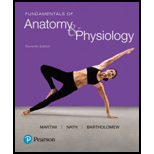
Fundamentals of Anatomy & Physiology (11th Edition)
11th Edition
ISBN: 9780134396026
Author: Frederic H. Martini, Judi L. Nath, Edwin F. Bartholomew
Publisher: PEARSON
expand_more
expand_more
format_list_bulleted
Concept explainers
Question
Chapter 16, Problem 10RQ
Summary Introduction
To determine:
The physiological activities that distinguish non-REM sleep from REM sleep.
Concept introduction:
Sleep can be defined as the period during which the person becomes unconscious, but can be awakened by the normal sensory stimuli. It is a natural phenomenon that occurs in all individual to restore the vitality of the body. There are two types of sleep, REM (rapid eye movement sleep) and non-REM (non-rapid eye movement sleep).
Expert Solution & Answer
Want to see the full answer?
Check out a sample textbook solution
Students have asked these similar questions
Describe REM and non-REM sleep.
Distinguish NREM sleep from REM sleep?
What is paradoxic sleep?
Chapter 16 Solutions
Fundamentals of Anatomy & Physiology (11th Edition)
Ch. 16 - Prob. 1CPCh. 16 - Prob. 2CPCh. 16 - Prob. 3CPCh. 16 - Prob. 4CPCh. 16 - Prob. 5CPCh. 16 - Prob. 6CPCh. 16 - Prob. 7CPCh. 16 - Prob. 8CPCh. 16 - Prob. 9CPCh. 16 - Prob. 10CP
Ch. 16 - Name the two types of cholinergic receptors on the...Ch. 16 - Prob. 12CPCh. 16 - Prob. 13CPCh. 16 - Prob. 14CPCh. 16 - Prob. 15CPCh. 16 - Prob. 16CPCh. 16 - Prob. 17CPCh. 16 - Prob. 18CPCh. 16 - Prob. 19CPCh. 16 - Prob. 20CPCh. 16 - Prob. 21CPCh. 16 - Prob. 22CPCh. 16 - Prob. 23CPCh. 16 - Prob. 24CPCh. 16 - Prob. 25CPCh. 16 - Prob. 26CPCh. 16 - Prob. 27CPCh. 16 - Prob. 28CPCh. 16 - Prob. 1RQCh. 16 - Prob. 2RQCh. 16 - Prob. 3RQCh. 16 - Prob. 4RQCh. 16 - Prob. 5RQCh. 16 - Prob. 6RQCh. 16 - Prob. 7RQCh. 16 - What are the components of a visceral reflex arc?Ch. 16 - Prob. 9RQCh. 16 - Prob. 10RQCh. 16 - Prob. 11RQCh. 16 - All preganglionic autonomic fibers release _____...Ch. 16 - Prob. 13RQCh. 16 - Prob. 14RQCh. 16 - Prob. 15RQCh. 16 - Prob. 16RQCh. 16 - Prob. 17RQCh. 16 - Prob. 18RQCh. 16 - Prob. 19RQCh. 16 - Prob. 20RQCh. 16 - Prob. 21RQCh. 16 - Prob. 22RQCh. 16 - Prob. 23RQCh. 16 - Prob. 24RQCh. 16 - Prob. 25RQCh. 16 - Prob. 26RQCh. 16 - Prob. 27RQCh. 16 - Prob. 28RQCh. 16 - Prob. 29RQCh. 16 - Prob. 30RQCh. 16 - Prob. 31RQCh. 16 - Prob. 1CCCh. 16 - Prob. 2CCCh. 16 - Prob. 3CC
Knowledge Booster
Learn more about
Need a deep-dive on the concept behind this application? Look no further. Learn more about this topic, biology and related others by exploring similar questions and additional content below.Similar questions
- What types of changes occur to human bodies during the REM sleep?arrow_forwardDescribe the three neutral systems that play an important role in the sleep-wake state?arrow_forwardHow does the interplay between sleep architecture, circadian rhythms, and neurochemical processes in the brain contribute to the regulation of sleep stages and the overall function and health benefits of sleep?arrow_forward
- Identify the stage of sleep described by using choices from the key. (Note that responses a–d refer to NREM sleep.)arrow_forwardcertain inhaled anesthetic agents are thought to open chlorine ion channels in the membranes of postsynaptic neurons in the brain, an effect that causes IPSPs. why might this action put a person "to sleep" during anesthesia?arrow_forwarddescribe the stages of sleep, their relationship to thebrain waves, and the neural mechanisms of sleep;arrow_forward
- Describe the categories and EEG patterns of sleep, and explain the possible benefits of these categories of sleep.arrow_forwardWhy is sleep important for our body? Name one thing that evidence supports why sleep is necessary. How many stages of sleep are there? Name the stages of sleep and at least two things that occur in each stage.arrow_forwardResearch suggests that PGO waves play an important role in generating REM sleep. PGO waves activate all of the following brain regions EXCEPT: A) the occipital lobes. B) the pons. C) the prefrontal cortex. D) the lateral geniculate nucleus.arrow_forward
arrow_back_ios
arrow_forward_ios
Recommended textbooks for you
 Human Anatomy & Physiology (11th Edition)BiologyISBN:9780134580999Author:Elaine N. Marieb, Katja N. HoehnPublisher:PEARSON
Human Anatomy & Physiology (11th Edition)BiologyISBN:9780134580999Author:Elaine N. Marieb, Katja N. HoehnPublisher:PEARSON Biology 2eBiologyISBN:9781947172517Author:Matthew Douglas, Jung Choi, Mary Ann ClarkPublisher:OpenStax
Biology 2eBiologyISBN:9781947172517Author:Matthew Douglas, Jung Choi, Mary Ann ClarkPublisher:OpenStax Anatomy & PhysiologyBiologyISBN:9781259398629Author:McKinley, Michael P., O'loughlin, Valerie Dean, Bidle, Theresa StouterPublisher:Mcgraw Hill Education,
Anatomy & PhysiologyBiologyISBN:9781259398629Author:McKinley, Michael P., O'loughlin, Valerie Dean, Bidle, Theresa StouterPublisher:Mcgraw Hill Education, Molecular Biology of the Cell (Sixth Edition)BiologyISBN:9780815344322Author:Bruce Alberts, Alexander D. Johnson, Julian Lewis, David Morgan, Martin Raff, Keith Roberts, Peter WalterPublisher:W. W. Norton & Company
Molecular Biology of the Cell (Sixth Edition)BiologyISBN:9780815344322Author:Bruce Alberts, Alexander D. Johnson, Julian Lewis, David Morgan, Martin Raff, Keith Roberts, Peter WalterPublisher:W. W. Norton & Company Laboratory Manual For Human Anatomy & PhysiologyBiologyISBN:9781260159363Author:Martin, Terry R., Prentice-craver, CynthiaPublisher:McGraw-Hill Publishing Co.
Laboratory Manual For Human Anatomy & PhysiologyBiologyISBN:9781260159363Author:Martin, Terry R., Prentice-craver, CynthiaPublisher:McGraw-Hill Publishing Co. Inquiry Into Life (16th Edition)BiologyISBN:9781260231700Author:Sylvia S. Mader, Michael WindelspechtPublisher:McGraw Hill Education
Inquiry Into Life (16th Edition)BiologyISBN:9781260231700Author:Sylvia S. Mader, Michael WindelspechtPublisher:McGraw Hill Education

Human Anatomy & Physiology (11th Edition)
Biology
ISBN:9780134580999
Author:Elaine N. Marieb, Katja N. Hoehn
Publisher:PEARSON

Biology 2e
Biology
ISBN:9781947172517
Author:Matthew Douglas, Jung Choi, Mary Ann Clark
Publisher:OpenStax

Anatomy & Physiology
Biology
ISBN:9781259398629
Author:McKinley, Michael P., O'loughlin, Valerie Dean, Bidle, Theresa Stouter
Publisher:Mcgraw Hill Education,

Molecular Biology of the Cell (Sixth Edition)
Biology
ISBN:9780815344322
Author:Bruce Alberts, Alexander D. Johnson, Julian Lewis, David Morgan, Martin Raff, Keith Roberts, Peter Walter
Publisher:W. W. Norton & Company

Laboratory Manual For Human Anatomy & Physiology
Biology
ISBN:9781260159363
Author:Martin, Terry R., Prentice-craver, Cynthia
Publisher:McGraw-Hill Publishing Co.

Inquiry Into Life (16th Edition)
Biology
ISBN:9781260231700
Author:Sylvia S. Mader, Michael Windelspecht
Publisher:McGraw Hill Education
Physiology of Sleep (Cycles and Waves); Author: USMLE pass;https://www.youtube.com/watch?v=LqY1Vn9y89A;License: Standard Youtube License